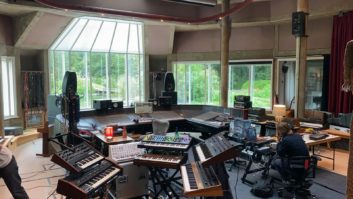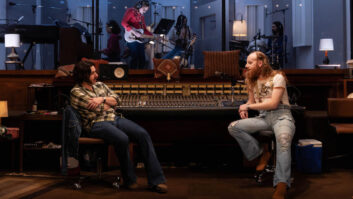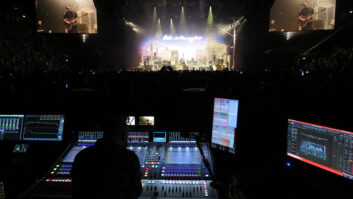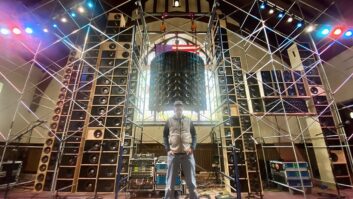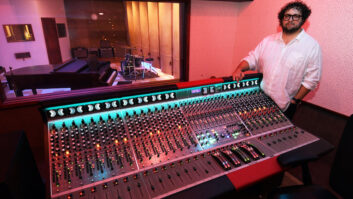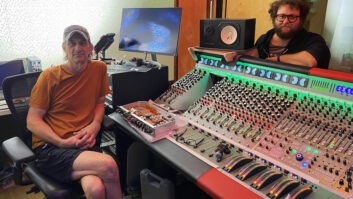In some ways, the 1991 Gulf War, in which the United States and its allies decimated the armies of Saddam Hussein and ended his takeover of oil-rich neighbor Kuwait, is a forgotten war. The U.S. victory was swift and overwhelming, American casualties were minimal and, of course, for the past two-plus years, we’ve been embroiled in a much more calamitous military escapade in Iraq, which has all but obliterated memories of the first campaign there.
photo: ©2005 universal studios. all rights reserved.
But now, the first Gulf War has been viscerally recalled in director Sam Mendes’ Jarhead, which is based on a best-selling memoir of the same name by Anthony Swofford. This very different war called for a different kind of war movie, too. There are no traditional combat scenes; rather, it focuses on Swofford’s interior life — what it means to be a soldier and how training and waiting for war can affect a person. The British-born Mendes, who won an Oscar for American Beauty and also directed the underrated gem Road to Perdition, has insisted that Jarhead is not an anti-war screed — just as Swofford’s gritty 2003 book is not explicitly anti-war. But it is perhaps telling that the U.S. military declined to assist the filmmakers. Perhaps they were too busy cooperating with Steven Spielberg on War of the Worlds, where the U.S. bravely take on alien invaders (but get annihilated until the very end).
If you’ve seen Mendes’ work, you know that he is a visual poet with a knack for “saying” as much with a well-designed shot as with a page of dialog. This is not to imply that he doesn’t get the most out of his actors; indeed, he is a master at conjuring subtle and nuanced performances from his actors. In Jarhead, Jake Gyllenhaal as “Swoff” and Jamie Foxx as Staff Sgt. Sykes head an outstanding ensemble cast. It’s not surprising to learn, too, that sound is very important to Mendes, and that his approach to that element of filmmaking doesn’t toe the conventional line either.
Jarhead was shot in the desert country surrounding El Centro, Calif., east of San Diego. Willie Burton was the location sound mixer there. Post-production was mostly at Skywalker Sound in Marin County, with Pat Jackson acting as supervising sound editor; Kyrsten Mate, sound designer and sound effects editor, along with Bob Shoup; Richard Quinn, dialog editor; Malcolm Fife, Foley mixer (Foley was walked at Fantasy Studios in Berkeley, Calif., by James Willetts and Ben Conrad); and David Parker, re-recording effects mixer. Working out of Sound One in Manhattan (where Mendes has a residence) were ADR supervisor Jane McCulley and dialog and music re-recording mixer Scott Millan, who has worked on all three of Mendes’ feature films. The final mix was also done at Sound One.
On the glorious September day driving along the serpentine back roads to rural Skywalker Ranch to talk to Jackson and Mate, I find post activity on two fronts. Inside the Technology Building’s main mixing studio, Parker is at the huge Neve DFC console and Fife is seated at a nearby Pro Tools station adding Foley to a scene the post folks call “The Highway of Death.” A convoy of Iraqis has been incinerated by American warplanes; all that remains is the charred shells of various vehicles, bodies burned beyond recognition (“crispies” in the soldiers’ argot), the stench of death and the buzzing of flies. Parker and Fife repeatedly run through the scene, making sure that every footstep and gear rustle works with the striking visuals. Meanwhile, outside the building in a secluded area between two hillsides dotted with curious longhorn cattle, Jackson is supervising the “worldizing” of an ADR track for a key scene — FX recordist Dan Gleich plays back a DAT of a noisy loop group’s work (cut in New York) through speakers and records it anew with a pair of distant mics to get some natural ambience on the track. “Using some digital reverb wasn’t going to do it,” Jackson explains. “Worldizing it makes it sound much more natural.”
Jackson, whose past sound supervisorial work includes The English Patient, The Talented Mr. Ripley and K-19: The Widowmaker (and whose long career as a sound editor dates back to the mid-’70s), speaks highly of Mendes’ approach to sound: “Sam uses sound almost in an emblematic way at times. Whereas on a film like [Peter Weir’s] Master and Commander you heard every rope creak when you were in the hold, Sam tends to use broader strokes. He uses sound like a swatch of paint rather than as pointillism, where you hear every mosquito.
Supervising sound editor Pat Jackson
“The first part of the job was extracting from Sam what he wanted,” she continues. “He has a lot of ideas of his own about sound, and he’s also very decisive, so you quickly learn the types of things that he likes and doesn’t like. But when he says he wants silence, he means no audio. For example, there’s a place in the movie where there’s incoming artillery for the first time, Sam wanted it to be absolutely silent as all these bombs are going off — yet the visual is really great because there’s this rain of grit and sand debris. The first time I saw it, I thought, ‘You want to hear that [rain of grit] because this whole movie is from Anthony Swofford’s point of view.’ It was that way in how it was shot and the way it was edited.
“So I wondered, ‘Could we have that sound?’ And initially he said, ‘No, I want it silent.’ Then, when you see the final version, it’s quite wonderful: The explosions start and they get distant and muffled and then it goes to absolute quiet and then there’s a subtle rain of grit. It’s a profoundly moving moment in the film because you really sense something about what it’s like to be there. So it was taking the director at his word of what the effect was that he wanted, but still experimenting around the edges, saying, ‘Take a listen to this.’ He’s totally open to possibilities. He’ll entertain ideas, but he’s also very quick to say, ‘Nope, I don’t want to hear that.’
“Sam likes to feel the environment that the action is happening in without having it intrude on what he wants to have the audience hear, whether it’s dialog or some action. He doesn’t want the clutter of extreme detail. Like there’s a moment when Jamie Foxx is giving a speech and he’s walking back and forth on a wooden floor, so, naturally, I would have wanted to put his footsteps in there, but Sam didn’t want it, so we didn’t do it. He wants sound to serve the moment; still, in the important moments, you don’t get the feeling that there’s not enough sound.”
So, it’s: “See a dog, and maybe you hear it, maybe you don’t”?
“You hear it if it’s important,” she says with a laugh.
Kyrsten Mate, sound designer and SFX editor
Even with Mendes’ somewhat quirky sonic sensibilities, there were still plenty of intriguing elements the sound crew focused on. For one, “The oil fires are almost like a character in the film,” says principal designer Mate, who has worked as a sound effects editor for more than a decade, with credits that include The English Patient, The Talented Mr. Ripley and K-19 with Jackson; and such films such as Chocolat, The Shipping News, AI: Artificial Intelligence, The Lord of the Rings: The Two Towers, Minority Report and The Incredibles. “I didn’t realize what those fires were like until I saw this film that Sam recommended I watch, Werner Herzog’s Lessons of Darkness [1992], which is a documentary about fighting the oil fires in Iraq and Kuwait during that war. Each of these fires is so big and forceful. It’s like 10 fire hydrants together all blowing this thick, viscous liquid up into the air and then it catches on fire.”
To capture the sound of the oil fires, Mate says, “I used a large variety of odd things: water pressure, obviously — a fire hose; also propane tanks dumping out compressed air; the sound of a [paint] spray booth — anything I could think of that has force and power. I had worked on The Lord of the Rings, and from that library I got lava flows, geysers and things that had been recorded by the New Zealand crew that were good for the low end. Then to give it some personality, I added some leopard exhales and inhales — they push a lot of air through their body cavities. Of course, you process it so it doesn’t sound like a leopard.” In the end, Mate had combined and processed about 20 tracks in Pro Tools to create the oil fire effect.
The desert itself is almost like a character, with its own moods and sounds. “There’s an otherworldliness about being in the desert,” Mate offers. “We feel transported and displaced. That’s what Sam does visually and that’s what happened to the soldiers, so he was trying to convey that.” Aurally, that translated to conjuring different desert winds and ambiences. “Yes, we’re quite attuned to winds here at Casa Jarhead,” she says with a chuckle. “There’s a great variety of hot winds. I went out to the desert in Nevada, far from any road, and recorded some things out there. I also had some good recordings from the Tunisian desert after The English Patient, so that was really helpful, too.” For the new recordings, Mate used a Sound Devices 722 2-channel recorder and an X/Y pair of Neumann SKM 140s, “which have a lot of nice low end,” she says.
“There’s a minimalist feeling to parts of the film,” she continues, “where you’re in this desolate place and it’s a hot day with no wind. And then there are also scenes with a lot going on — putting up camp and lots of vehicles and that sort of thing.” For the latter, Jackson sent a pair of recordists down to El Centro to capture humvees, Jeeps, tanks and planes during the film’s actual production. A separate weaponry session took place at a remote canyon locale in Marin. Mate was also excited about getting to do “some real dude stuff”: For a scene in which some flares are inadvertently set off, she put parachute flairs on long cables and then recorded the passbys. “It was very forceful and in-your-face,” she comments.
“In this film, though, there are all sorts of things you hear but don’t see, so you have to create an offscreen world,” Mate says. “The war is happening three miles away and you don’t see it, so you have to treat the [recordings of] explosions so that they sound distant. I used a lot of different kinds of EQs and reverbs to help me, but a lot of it was picking the right sound that would help convey it. You can’t have too much of the crack of the head of an explosion because that’s what you hear when you’re standing next to it. You need more of the low-end boom, which is what you’d hear from farther away. Sometimes it felt like we were making a radio play because there was so much offscreen sound. Then it becomes a question of keeping that out of the way of what Sam is focusing on in the scene.”
In the end, it came down to Mendes’ tastes and desires. As Jackson put it, “The test of making a soundtrack is to bring what you have — your aesthetic sensibility — in the service of the vision of the director, or the picture editor and the director.”
In this case, the picture editor also happened to be one of the true legends of sound design, Walter Murch (who also has a credit as re-recording mixer). “He would definitely step forward occasionally and say, ‘Well, what about…?’ So he had a lot of input, as well,” says Mate. “He’s very good at articulating what he likes or doesn’t like about a sound, which is very helpful. It’s never just, ‘I don’t like it.’ I’ve known him for a long time, and he’s always been such a nice guy to me.”
Adds Jackson, “I came through the Walter Murch school of sound design. I started on The Conversation and worked on The Godfather II and Apocalypse Now, so he’s had a profound influence on me. Not so much technically, but in how to listen, how to pay attention, how to pick the sound that tells you what the quality of the audio in the space in the story is. Walter has set the bar pretty high for being open to ideas and listening to them, wherever they come from, and to entertain the wildest possibilities.
“So his opinions are formative, but it’s really Sam that is the guiding light that we’re orienting the sound around: Is this what he wants? Is this what he’s going for in this scene? And the nice thing about Sam is his clarity and his directness and his understanding of sound, and Walter’s main effect on the sound is inspiration. And if Walter likes it, it’s fun. Same with Sam. One of the most satisfying things we do is we get a charge from good work — our own or someone else’s. So when the magic happens onscreen and the sound you’ve brought to the table really changes something or enhances it, that’s what we live for.”


